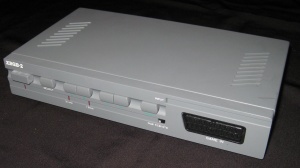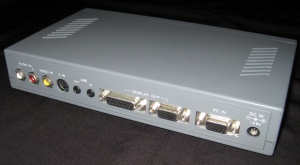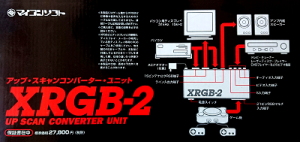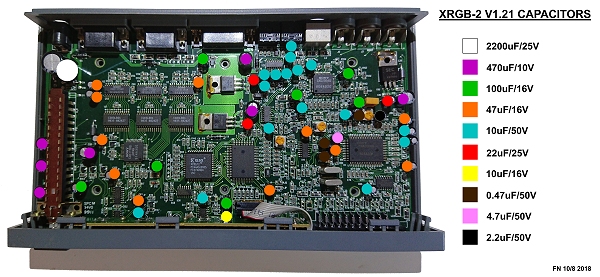Difference between revisions of "XRGB-2"
(→Super Mode menu) |
|||
| Line 1: | Line 1: | ||
| − | [[File:xrgb-2_front.jpg|300px|thumb|right|XRGB-2 | + | [[File:xrgb-2_front.jpg|300px|thumb|right|XRGB-2 Front]] |
| − | [[File:xrgb-2_back.jpg|300px|thumb|right|XRGB-2 | + | [[File:xrgb-2_back.jpg|300px|thumb|right|XRGB-2 Back]] |
| + | [[File:Xrgb2box.png|300px|thumb|right|XRGB-2 Box]] | ||
The [[XRGB-2]] is an upscan converter by [[Micomsoft]]. It has limited capabilities when compared to the newer units such as the [[XRGB-2 plus]] and the [[XRGB-3]], nevertheless it offers great performance. The stability of the image is rock solid, and you usually don't need to fiddle with settings as much as with later units. | The [[XRGB-2]] is an upscan converter by [[Micomsoft]]. It has limited capabilities when compared to the newer units such as the [[XRGB-2 plus]] and the [[XRGB-3]], nevertheless it offers great performance. The stability of the image is rock solid, and you usually don't need to fiddle with settings as much as with later units. | ||
Latest revision as of 18:25, 10 August 2018
The XRGB-2 is an upscan converter by Micomsoft. It has limited capabilities when compared to the newer units such as the XRGB-2 plus and the XRGB-3, nevertheless it offers great performance. The stability of the image is rock solid, and you usually don't need to fiddle with settings as much as with later units.
It offers no remote control, and all functions are available through five buttons on the unit's front. It offers just one scanline setting, equivalent to the 127 setting (50%) on the XRGB-3.
Contents
Menu
| Japanese | English | Setting | Default setting | Use |
|---|---|---|---|---|
| 明るさ | Brightness | 0 - 62 | 41 | Adjust white level |
| BLUE | 0 - 62 | 31 | Adjust blue | |
| GREEN | 0 - 62 | 31 | Adjust green | |
| H_POS | 0 - 7 | 4 | Adjust horizontal position | |
| BLACK | 0 - 62 | 0 | Adjust black level | |
| GAMMA | OFF / 1 / 2 / 3 / 4 | OFF | Adjust gamma | |
| USE_CH | S+VIDEO / S VIDEO | S+VIDEO | ||
| V_SYNC | AUTO / 50HZ / 60HZ | AUTO | ||
| AFC | 0 - 8 | 0 | ||
| DTC_TYP | NTSC / PS / USER | NTSC | ||
| USR_DTC | 1 - 62 | 59 | ||
| V_LINE | OFF / ON | OFF | Scanlines |
| Menu Heading | Explanation | Allowable Range | Default |
|---|---|---|---|
| BRIGHTNESS | Adjust white level | 0 - 62 | 41 |
| BLUE | Adjust blue | 0 - 62 | 31 |
| GREEN | Adjust green | 0 - 62 | 31 |
| H_POS | Adjust horizontal position | 0-7 | 4 |
| BLACK | Adjust black level | 0-62 | 0 |
| GAMMA | Adjust gamma | OFF / 1 / 2 / 3 / 4 | OFF |
| USE_CH | Selection of usable terminal(s) | S+VIDEO / S VIDEO | S+VIDEO |
| LANGUAGE | Language | JPN / ENG | JPN |
| CRT SYNC | Sync Polarity | NEG / POSI | NEG |
| V_SYNC | Vertical sync rate | AUTO / 50HZ / 60HZ | AUTO |
| 15/31 SCAN | Resolution | 15KHZ/31KHZ | 31KHZ |
| IIC USE | *insert explanation* | OFF / ON | ON |
| AFC | Upper screen distortion correction | 0-8 | 0 |
| AFC SAVE | Saving AFC setting when shutting off | OFF / ON | OFF |
| AFC BOW | *insert explanation* | Middle | |
| AFC ANGLE | *insert explanation* | Middle | |
| AFC DEF | *insert explanation* | 0 | |
| RESET LOCK | *insert explanation* | OFF / LOCK1 / LOCK2 | LOCK1 |
| SUPER MODE | Super Mode | OFF / ON | OFF |
| D/A LEVEL | *insert explanation* | ||
| A/D LEVEL | *insert explanation* | ||
| DTC_TYP | Dot clock selection | NTSC / PS / USER | NTSC |
| USR_DTC | User dot clock adjustment | 1 - 62 | 59 |
| V_LINE | Scanlines | OFF / ON | OFF |
Super Mode is available when starting the unit and waiting for five seconds then press select
and menu simultaneously and then press up, up, down, down, left, right, left, right, select and menu.
Note! that this is when using the RGB input (GAME IN) using the other inputs has a few unique extra features not shown here.
Specifications
Inputs
It also has passthrough for:
- VGA
- RCA Audio
- Mini Jack
Outputs
- VGA at 640x480 31khz
- RGB in 15-pin D-sub (for older Japanese monitors)
- Mini Jack for audio output
Capacitor List
| Ver 1.21 PCB |
|---|
| HOLE: C158 2200uF/25V |
Manual
FAQ
What is the "RGB/PCB STD" switch for?
This little switch physically activates a set of 220 ohm resistors, allowing the use of arcade game pcbs on your display device. This is needed since the video level used by PCBs is higher than the one used by game consoles, the resistors make them equivalent.
How to reset XRGB-2
When the unit is powered down, press all four buttons (up, down, left and right) and then power on the unit. All values will be reset to factory defaults.
Important : about GAME IN input (RGB-21)
Never directly use the European standard SCART cables with an XRGB-2 since the pinout is different to the Japanese standard RGB-21 ones, and damage might result due to voltage applied on signal lines.
Power Supply
Power supplies tend to fail. It requires 12V 0.5 Amp, center positive. Less than 12 and more than 11 tends to give a wobbly image, and less than 10V turns on the LED without output.
Scanlines
This unit has only one scanline setting, and is activated by turning on the last option in the menu, named V_LINE.
In order to compare the scanlines to those of the XRGB-3, several pictures were taken at different scanline levels. The results matched at level 127 of the XRGB-3. The same cables, arcade PCB, camera settings and TV were used to connect and compare them. The images show a cropped section of pure white on the CRT calibration screen of a System 16 board.

|
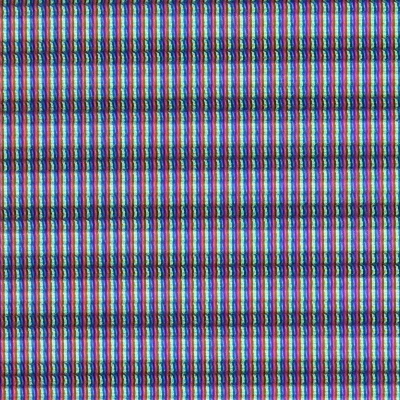
|
| XRGB-2 with scanlines photo | XRGB-3 with scanlines at 127 |
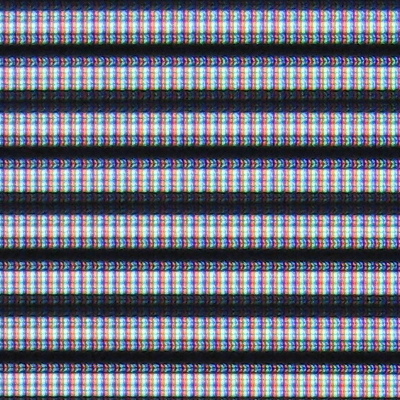
|
| XRGB-3 with scanlines at 001 for reference |
